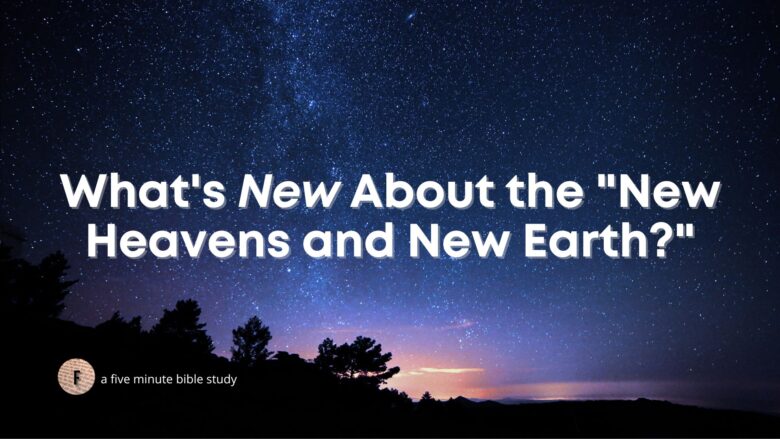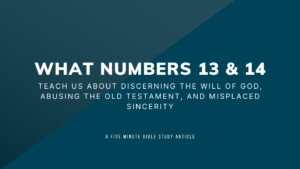For some number of years, there has been a fixation on the “new heavens and new earth”1 in biblical prophecy, what it is, and what it will be like. Much of the discourse about this prophetic phenomenon revolves distinctly around whether or not it signifies a re-creating of the physical earth after the judgment (aka: a refurbished earth). It is difficult to find a modern commentator who disagrees with this “refurbished earth” interpretation. Because of this modern influence and foregone assumption that the Bible is predicting the re-creating of the physical earth when it speaks of a future NHNE, I believe that much of what the Bible actually says about this phenomenon is missed in all the excitement. In this article, I would like to take a focused look at what the Bible does tell us about the new creation that is first spoken of by Isaiah. Ultimately, I want to answer the question, “What is new about the new heavens and new earth?”
The Origins of “New Heaven and New Earth”
“New heavens and new earth” is stock language from Isaiah 65 & 66. It is first found in Isaiah 65:17— “For behold, I create new heavens and a new earth; and the former shall not be remembered or come to mind.” This is no new revelation to Bible readers familiar with their Old Testaments. But just in case you are unfamiliar with this terminology in scripture, below is a parallel listing of all the places where this exact phrase is found in scripture.
Isaiah 65:17— “For behold, I create new heavens and a new earth; and the former shall not be remembered or come to mind.”
Isaiah 66:22— “For as the new heavens and the new earth which I will make shall remain before Me,” says the Lord, “So shall your descendants and your name remain.”
2 Peter 3:13— “Nevertheless we, according to His promise, look for new heavens and a new earth in which righteousness dwells.”
Revelation 21:1— “Now I saw a new heaven and a new earth, for the first heaven and the first earth had passed away. Also there was no more sea.”
Straightaway, without considering any context, it does appear that Isaiah, Peter, and John are all signifying that God will re-create or refurbish this old earth at the time of the judgment. This article is not intent on deconstructing this “refurbished earth” interpretation of these verses. However, as I try to elucidate on what and where the Holy Spirit focuses His attention when describing this new creation in the greater context of these texts, I believe considerable doubt will be cast on this otherwise straightforward conclusion that many people have regarding the NHNE.
That Peter and John are using stock language from Isaiah is apparent from three observations. First, Peter alludes to “the words which were spoken before by the holy prophets” (2 Peter 3:2) and also says that God’s people were promised a NHNE prior to 2 Peter being written (v. 13). Second, if you scour the Bible prior to 2 Peter, you will not find this terminology anywhere besides Isaiah 65:17 & 66:22. Third, John makes another allusion to Isaiah’s prophecy about the NHNE when he says in Revelation 21:4, “the former things have passed away,” (see Isaiah 65:16-17). Clearly, Isaiah 65 & 66 are the source. Given that Isaiah is the source, it is very important to go back to the original source when trying to learn the truth about a matter. So, let’s do that.
The Structure of Isaiah 65 & 66
I always like to get a bird’s eye view of the text I’m looking at if possible. After all, it’s when we get tunnel-vision on a single verse or statement in scripture, that we lose the forest for the trees in interpretation. There are several structural proposals for Isaiah 65-66 as there are for any large text of scripture. And while I will put forth my proposal for a helpful structure to aid studying, virtually all proposed structures will bring out the major parallels within these two chapters.
(A) Israel’s Rebellion & Judgment (65:1-7)
(B) The Faithful Remnant Blessed (65:8-10)
(A’) Israel’s Judgment (65:11-16)
(B’) The Faithful Remnant Blessed—the NHNE (65:17-25)
(A) Israel’s Rebellion & Judgment (66:1-4)
(B) The Faithful Remnant Blessed (66:5-13)
(A’) Israel’s Judgment (66:14-19)
(B’) The Faithful Remnant Blessed—the NHNE (66:20-24)2
You should notice that Isaiah iterates and reiterates 1) the rebellion and judgment of physical/current Israel, 2) God’s blessing on the faithful remnant, and 3) namely, God’s blessing to the remnant in terms of a new creation (i.e., NHNE). Noticing the structure of a text is helpful, because one parallel section of verses may help with the interpretation of symbols and details in the counterpart section of verses that may prove more difficult. I believe that will prove true in Isaiah 65 & 66.
In the parallel verse sets below, I have taken all the (B) related sections from the structure above and placed them in side-by-side parallel setting so you can easily see word or concept repetitions from one section to the next.
| (B) The Faithful Remnant Blessed (65:8-10) | (B’) The Faithful Remnant Blessed NHNE (65:17-25) | (B) The Faithful Remnant Blessed (66:5-13) | (B’) The Faithful Remnant Blessed NHNE (66:20-24) |
| 8 Thus says the Lord: “As the new wine is found in the cluster, and one says, ‘Do not destroy it, for a blessing is in it,’ so will I do for My servant’s sake, that I may not destroy them all. 9 I will bring forth descendants from Jacob, and from Judah an heir of My mountains; My elect shall inherit it, and My servants shall dwell there. 10 Sharon shall be a fold of flocks, and the Valley of Achor a place for herds to lie down, for My people who have sought Me. | 16 So that he who blesses himself in the earth shall bless himself in the God of truth; and he who swears in the earth shall swear by the God of truth; because the former troubles are forgotten, 17 “For behold, I create new heavens and a new earth; and the former shall not be remembered or come to mind. 18 But be glad and rejoice forever in what I create; for behold, I create Jerusalem as a rejoicing, and her people a joy. 19 I will rejoice in Jerusalem, | 5 Hear the word of the Lord, you who tremble at His word: “Your brethren who hated you, who cast you out for My name’s sake, said, ‘Let the Lord be glorified, that we may see your joy.’ But they shall be ashamed.” 6 The sound of noise from the city! A voice from the temple! The voice of the Lord, who fully repays His enemies! 7 “Before she was in labor, she gave birth; before her pain came, she delivered a male child. 8 Who has heard such a thing? Who has seen such things? Shall the earth be made to give birth in one day? Or shall a nation be born at once? For as soon as Zion was in labor, she gave birth to her children. 9 Shall I bring to the time of birth, and not cause delivery?” says the Lord. “Shall I who cause delivery shut up the womb?” says your God. 10 “Rejoice with Jerusalem, and be glad with her, all you who love her; rejoice for joy with her, all you who mourn for her; 11 That you may feed and be satisfied with the consolation of her bosom, that you may drink deeply and be delighted with the abundance of her glory.” 12 For thus says the Lord: “Behold, I will extend peace to her like a river, and the glory of the Gentiles like a flowing stream. Then you shall feed; on her sides shall you be carried, and be dandled on her knees. 13 As one whom his mother comforts, so I will comfort you; and you shall be comforted in Jerusalem.” | 20 Then they shall bring all your brethren for an offering to the Lord out of all nations, on horses and in chariots and in litters, on mules and on camels, to My holy mountain Jerusalem,” says the Lord, “as the children of Israel bring an offering in a clean vessel into the house of the Lord. 21 And I will also take some of them for priests and Levites,” says the Lord. 22 “For as the new heavens and the new earth which I will make shall remain before Me,” says the Lord, “So shall your descendants and your name remain. 23 And it shall come to pass that from one New Moon to another, and from one Sabbath to another, all flesh shall come to worship before Me,” says the Lord. 24 “And they shall go forth and look upon the corpses of the men who have transgressed against Me. For their worm does not die, and their fire is not quenched. They shall be an abhorrence to all flesh.” |
You will notice in these four parallel sections about God’s blessing of His faithful remnant which entails a new creation, the emphasis is on God’s people (i.e., servants, elect, descendants of the Lord, brethren, Gentiles, the people of Jerusalem). When contrasted with the parallel sections about Israel’s rebellion and judgment, the obvious contrast is between God’s unfaithful people in Isaiah’s day and God’s faithful remnant in the future. The Israel of Isaiah’s day is corrupt, idolatrous, and reserved for judgment, but out of this germ God is going to create new wine, a new people, a new Jerusalem, to include Gentiles. The NHNE is not a new physical earth, but it is, at the very least, a New Israel created by God.3 The visual from Isaiah 65:17-18 makes this clearer.
17 For, behold, I create new heavens and a new earth:
and the former shall not be remembered, nor come into mind.18 But be ye glad and rejoice for ever in that which I create:
for, behold, I create Jerusalem a rejoicing, and her people a joy. 19 And I will rejoice in Jerusalem, and joy in my people.4
Notice another important contrast in 65:16-17.
16 … because the former troubles are forgotten,
And because they are hidden from My eyes.
17 “For behold, I create new heavens and a new earth; and the former shall not be remembered or come to mind.
The NHNE of v. 17 is contrasted with “the former,” whatever that is. If you restrict yourself to firsthand assumptions and tunnel vision in v. 17, it might seem reasonable to assume that Isaiah is contrasting the old, corrupt, physical earth that we now live on with the new heavens and new earth that God will create in the future. Unfortunately, this does not follow with what Isaiah has been talking about up to v. 16-17. Notice Isaiah 65:1-16 describes the current troubles in the nation of Israel that are leading to its sure judgment. This long listing of troubles builds up to v. 16 & 17 when Isaiah says, “When I perform my new creation, these current troubles (rebellious Israel) will be in the past and forgotten.” This is very similar to Jeremiah’s contrast of Israel in His day with the new Israel to come in the future, “I will be their God, and they shall be My people… for I will forgive their iniquity, and their sin I will remember no more” (31:33-34). The ultimate takeaway from this contrast in Isaiah 65:16-17 is this: the thing being done away with when then NHNE is created is not the old earthly elements, at least, not in Isaiah 65:17. It is the rebellious people of Israel and the troubles they have caused God and His faithful remnant. You might could say: the troubles of sin will be done away with. That is the import of meaning that Paul gives in 2 Cor. 5:17 when he says, “Therefore, if anyone is in Christ, he is a new creation; old things have passed away; behold, all things have become new.
What’s New About the NHNE?
This question – what’s new about the NHNE – was answered in short using Isaiah 65 & 66 as the basis. However, the answer can be colored in further by traveling in time to the New Testament scriptures where we have already observed that other writers pick up this Isaianic language. There are three New Testament chapters that are commonly cited by those who advocate for a refurbished earth interpretation of the NHNE: Romans 8; 2 Peter 3; Revelation 21. These chapters are, no doubt, helpful in filling in the details. For example, Romans 8 does not use the exact phrase NHNE, but it does speak of God’s creation and that creation’s bodily resurrection hope (v. 18-25). I agree that this is a helpful passage in understanding more about the NHNE, though I do not subscribe to the idea that Romans 8 teaches a renovating of the physical, earthly creation. At least one of the things new about the NHNE that Romans 8 divulges is that God’s new creation will include redeemed bodies (v. 23). Other verses like Revelation 21:4 further elaborate that these redeemed bodies will not die or decay.
If we follow the emphasis of Isaiah 65-66, and we understand that the NHNE is primarily about the glorified state of God’s people posterior to Isaiah’s time, then there are several new things we learn about the NHNE. The following is a list of features characteristic of God’s new creation people. These features would be true of God’s faithful remnant and newly created people future to Isaiah and in contrast to the state of affairs in the prophet’s present day.
What is new about the new state of God’s people?
1. It will include Gentiles (Is. 65:1; 66:18-23; Rev. 21:24).
2. Physical Israel will no longer be included by nature of birth (Is. 65:13-16; 66:2-4, 17).
3. It will include eternal peace/rest (Is. 65:19-25; Rev. 21:4).
4. It will be more glorious than God’s former creation: the physical nation of Israel (Is. 66:10-13).
5. God’s people will be dwelling with Him in an escalated sense/capacity (Rev. 21:9-27).5
6. Ultimately, it will not be on the physical earth (2 Peter 3:1-13).6
7. Salvation will be realized and sins forgotten (Is. 65:16-17; 2 Cor. 5:17)
8. It will include immortal, resurrected bodies (Rom. 8:23; Rev. 21:4)..
9. It will include victory over the enemy (Is. 65:25; 66:24; Rev. 21:7-8, 27; 22:14-15).
Tying Up Loose Ends
Hopefully this writing has answered some questions you had about the NHNE, but perhaps it has raised even more. Again, this article is not meant to serve as a blow-by-blow response to the refurbished earth theory. As I said from the beginning: this was written to take a focused look at what the Bible does tell us about the new creation that is first spoken of by Isaiah in his 65th and 66th chapters. If we are going to learn anything about what the NHNE is all about, it’s important to go to the source. You should have noticed that Isaiah’s focus is on the rebellious state of Israel in his day, contrasted with the glorious, righteous, and protected state of God’s people in the age to come relative to Isaiah. The focus is not on a spectacular new, physical earth to come in the future. This idea is foreign to Isaiah 65-66.
One question that may be raised is, when exactly does the NHNE appear that Isaiah prophesied about? This is a good question. Peter indicates the NHNE was in some capacity still future to even him (2 Peter 3:13). However, details in Isaiah 65-66 indicate that its coming would be fulfilled in some real sense within the days of the Messianic kingdom on the earth. Consider the following proofs for this latter claim:
• In Isaiah’s figurative description of how things will be in the NHNE, death and old age are still realities (Is. 65:17-20). There is no death in John’s description in Revelation 21, but there is in Isaiah’s description. It does not make sense to use death as a symbol to describe conditions of the remnant in the eternal state.
• Isaiah 65:25 is a direct allusion to 11:6-7 which is clearly a Messianic prophecy fulfilled in the time of the church age when 11:10 is considered. Isaiah 11:10 says, “And in that day there shall be a root of Jesse (Christ), who shall stand as a banner to the people; for the Gentiles shall seek Him…”
• Isaiah 66:18-23 also speaks of the NHNE being fulfilled when Gentiles become part of God’s remnant. This also is “kicked off” in the church age.
How is it that the NHNE is fulfilled in the church age but is still future during that age (i.e., 2 Peter 3:13)? The answer lies in what has been called the Already-Not Yet kingdom concept or the Inaugurated-Consummated kingdom concept.7 That is, within Old Testament prophecy and the New Testament scriptures, the kingdom of God is spoken of in terms of having already arrived in one sense but being still future in another sense. This is captured succinctly when Jesus uses the phrase, “The hour is coming and now is…” in John 4:23; 5:25, 28; and 16:32. When Isaiah describes the NHNE, he brings us up to the church age as it were. When Peter and John describe the NHNE, they pick up where Isaiah left off and get us to the resurrection age. Thus, the NHNE has already been “kicked off” in the church age, but it still awaits a future glory to come in the resurrection age. With that said, we must not misconstrue the NHNE language when Peter and John use it, for they are borrowing language from Isaiah that had real, definite meaning. Whatever it meant to Isaiah, it cannot take on a completely new meaning when used by Peter and John unless there is warrant and good evidence.
Conclusion
We look forward to a time when the glorified state of God’s people is realized as we dwell in His immediate presence in a way that we have not experienced in any time prior. What a wonderful hope we have as the new creation of God.
1 New Heavens and New Earth = NHNE
2 This is a pretty clean structure of the two chapters. The most prominent point of contention can be found in (B’) of both blocks. 66:24 clearly speaks of divine judgment on the wicked. There is not a clear divine judgment on the wicked at the end of Ch. 65. One could argue that 65:25 is parallel divine judgment language, but it is certainly not as clearcut.
3 I agree with Edward J. Young’s assessment of the NHNE in Is. 65:17. He says, “Heaven and earth are employed as figures to indicate a complete renovation or revolution in the existing course of affairs. With the advent of the Messiah the blessing to be revealed will in every sense be so great that it can be described only as the creation of a new heaven and a new earth.” (Young, Edward J. The Book of Isaiah, Vol. 3. Grand Rapids, Eerdmans Publishing Company, p. 514)
4 This was borrowed from chiasmusxchange.com: https://www.chiasmusxchange.com/2017/07/03/isaiah-658-25/
5 Note: In Revelation 21, like in Isaiah 65-66, Jerusalem is not a reference to the physical coordinates on the map. Jerusalem is used metonymically to speak of the inhabitants of Jerusalem, spiritual Israel, God’s new creation people dwelling with God. See Rev. 21:2 & 9-10 where Jerusalem is compared to a bride, and subsequently, the bride is compared to the glorified city.
6 Peter utilizes four different Greek expressions to communicate what will happen to the earth at the second coming of Christ (i.e., G3928, G3089, G2618, G5080). It would seemingly be as difficult to avoid the idea of annihilation of the earth in 2 Peter 3 as it would be to get the new heavens and new earth to be a literal earth in Rev. 21.
7 For a fuller explanation of this concept, watch this sermon I gave called “The Kingdom of David & Solomon”
Battey, Aaron. “The Kingdom of David & Solomon.” YouTube, uploaded by Chapel Grove Church of Christ, 21 July 2022, https://youtu.be/N7tJlU_YzqA



